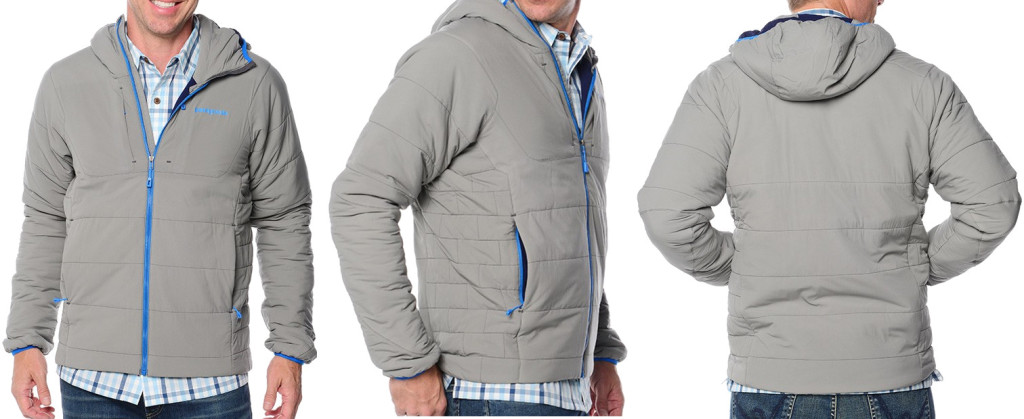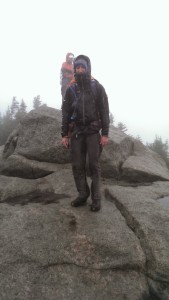With Patagonia’s latest Nano-Air technology, they promise material that is warm, stretchy, and breathable, and claim that you should be able to wear it for the entirety of any stop-and-start aerobic exercise. We were very excited to test out these claims when Patagonia sent us a Nano-Air Hoody to review (men’s, women’s). For this review, we not only wore the jacket on a day-to-day basis, but also took it on a four mountain trek in the Dix Mountain Range in the Adirondacks.
Key Features:
- 100% nylon ripstop shell and plain-weave liner.
- 60-g FullRange Insulation, which offers 40CFM wind-resistance.
- Hood that stays tight on your head, but can easily be stretched to pull it over of off of your head during a hike.
- 2 “handwarmer” pockets and two chest pockets, all with zippers.
- Durable Water Repellent (DWR) finish.
- Lightweight, coming in at 385g (13.6oz)
- Compresses down very small when packing.
Comfort:
The Nano-Air Hoody has an exceptionally good fit that is close to your body, yet the material stretches easily so that you do not feel confined. On our hike in the Dix Mountain Range, there were technical components that required the use of upper-body strength to climb over rocks. The jacket never got in the way, and was very flexible.
The jacket feels very light, coming in at less than one pound. Do not let this lightness fool you. The jacket is warm and provides great insulation. The liner material is very soft, which is great if you are wearing a t-shirt underneath. The hood fits great, and has a very snug fit. You can easily pull it and stretch it over your head, and once it is on, it will stay there. For the entire duration that I wore the hood on my trip, the hood did not fall off once, and fit comfortably. Again, the material is very stretchable, so the hood never felt too tight at any point. The inside of the hood is the same soft liner that fills the rest of the jacket, which provides warmth and softness.
The only complaint I had while wearing this jacket was on my hike when I had the hood off and did not have the zipper zipped all the way up to the top. Because the zipper zips up past the bottom of your neck, there were a few times where the unzipped zipper kept hitting the base of my neck. Zipping the zipper all the way to the top resolved this problem, but there were certain cases where it was too warm to do that while remaining comfortable.
Design:
As I have already mentioned numerous times, this jacket is lightweight. It also compresses down very small, making it a great addition to any backpacker’s pack. The zippers are easy to zip/unzip, and feel durable. However, there were two aspects of the design that leave something to be desired.
First, and most importantly, there are no armpit zippers on the jacket. Although the jacket is designed to be very breathable, it is always nice to have the option to unzip the armpits to help vent out excess heat. Overall, I did not find it to be a huge issue during my hike, but still think it might have offered some extra ventilation for warmer parts of the hike.
Second, there are no inside pockets in the jacket. Now, if you are wearing this solely as a mid-layer jacket, this isn’t an issue at all. There is plenty of room to store stuff in the outer pockets. However, if you plan on getting the most out of this jacket and plan on wearing it as your outer-layer during the certain parts of the year (afterall, it has a durable water resistant coating and offers some wind-resistance), it would be nice to have an area inside to store additional items.
Style:
 I don’t know if I have ever received so many compliments on a jacket before. We received the Feather Grey version of the jacket, which features a grey exterior with blue highlights. The inside liner of the jacket is a dark blue. I’ve had coworkers, family members, and friends comment that the jacket looked really nice. I agree, and plan on making this my main jacket until the colder winter seasons. I’ve been wearing it almost everyday since I received it.
I don’t know if I have ever received so many compliments on a jacket before. We received the Feather Grey version of the jacket, which features a grey exterior with blue highlights. The inside liner of the jacket is a dark blue. I’ve had coworkers, family members, and friends comment that the jacket looked really nice. I agree, and plan on making this my main jacket until the colder winter seasons. I’ve been wearing it almost everyday since I received it.
Warmth:
The Nano-Air Hoody is made with 60-g FullRange Insulation, and offers 40CFM wind resistance. This section deserves to be broken down into two components, one for regular day use, and another for hiking (aerobic activity).
Day-to-Day:
I received this jacket a few weeks before my camping trip to the Adirondacks, and luckily, that just happened to be the time that we started getting fall weather in Western New York, with temperatures ranging from the mid 40’s-60’s (Fahrenheit). I wore this jacket daily to work and throughout the day, and wore it to a soccer game. With the temperatures between mid 40’s-60’s, I did not feel cold, even when sitting still in the stands at the soccer game. Most of the time, I wore either a light long sleeve shirt underneath or a t-shirt. On days with warmer temperatures, I usually had the jacket unzipped. When the temperature was in the mid to upper 60s, I took the jacket off. If the temperatures were in the low 40’s, I would definitely consider wearing a shell, or a warmer shirt underneath. In the winter months, I will probably pass on the Nano-Air Hoody, and wear a jacket with a little more insulation.
Hiking:
During our trip to the Adirondacks, it was pouring rain. In the morning, I initially wore a short-sleeve base layer and my shell. As we approached the top of the second of four mountains, it was getting colder, and I had decided to take off my base layer because it was soaking wet.I simply wore the Nano-Air Hoody and my shell. Right away, I felt much warmer. As we continued to hike and take breaks, I stayed warm when we stopped. While hiking, I didn’t have to take the jacket off, although there were times where I had to unzip my shell and the Nano-Air. Again, this would have been a great time to have some armpit zippers to let excess heat out. I was worried that by not having a base layer with wickable material, that I would soon start sweating and the jacket would get damp. I wore the jacket up the last two mountains and the entire trek back to our lean-to. Mind you, this entire journey took us about 10 hours to hike in pouring rain. By the time we got back, the jacket was slightly damp, but I didn’t really expect it to be completely dry after hiking in rain for that long.
Side note: with the intensity of the rain, I would not have considered wearing this jacket as my outermost layer. Even my shell, which offers more water resistance than the Nano-Air, was very wet by the end of the hike.
Value:
We found the Nano-Air Hoody’s $299 price tag to be on the higher side for a jacket of this type. The jacket really does offer a lot, but I would be hesitant to wear it in certain conditions. For example, if it was pouring rain, you would still need a shell. When it is around or slightly over 60 degrees, the jacket can be on the warmer side, and there are no armpit zippers. Coming from Western New York, we have cold winters. I am not sure I would wear the Nano-Air Hoody in the middle of winter when it is near zero degrees. The 120g mid layer I own cost me $130, and it has both armpit zippers and an inside pocket. Granted, I would not want to wear the 120g mid-layer in 55-60 degree weather even with armpit zippers, but I also didn’t pay $300 for it.
- Stylish
- Lightweight
- Breathable
- Expensive
- Would consider a jacket with more insulation for very cold temperatures
- No armpit zippers



I am huge patagonia fan. And i was tempted with this product. But the price/value wasnt there for me either. I think theyll either lower the price or rebuild the garmet to make it more desirable.
[…] With Patagonia’s latest Nano-Air technology, they promise material that is warm, stretchy, and breathable, and claim that you should be able to wear it for the entirety of any stop-and-start aerobic exercise. We were very excited to test out these claims when Patagonia sent us a Nano-Air Hoody to review (men’s,women’s). For this review, we not only wore the jacket on a day-to-day basis, but also took it on a four mountain trek in the Dix Mountain Range in the Adirondacks. Read more… […]
How was the fit under a hardshell? I am definitely considering pick up the Nano Air Hoodie but I am wondering about the sizing and how the fit is when used in the way you did under a hardshell. Also, do you think this would give you decent warmth in colder temps with a solid base layer underneath?
Thanks for the review!
Jonathan,
The jacket is not bulky, so it fit great under my hard shell. I am 5’11” and roughly 150lbs, and I wear a size small nano-air. I wear a small in all of the jackets I own.
If you are planning on being active, the nano-air will keep you warm. However, when it is around freezing temperatures, I usually choose a heavier mid-layer if I know that I will have significant down time. It really depends on what activity you are using it for. For instance, if I wore this jacket snowboarding, it would do a great job keeping me warm when I am going down the hill and am being active. However, I think I would want something a little warmer for when I was on the chair lift sitting around in cold wind. When I am out hiking or running, even in colder temperatures, I will wear the nano-air with a light base layer because I know I won’t have much down time. When going on longer runs, I’ve worn this jacket as my outermost layer in high 20 degree (Fahrenheit) temperatures, and I felt great. As you noted, a warmer base layer would probably make up for some of the concerns I have with colder temperatures when sitting around, but I think this will all come down to personal preference and how cold you normally get.
I can’t stress this enough: the nano-air is really a great jacket for when you are active.